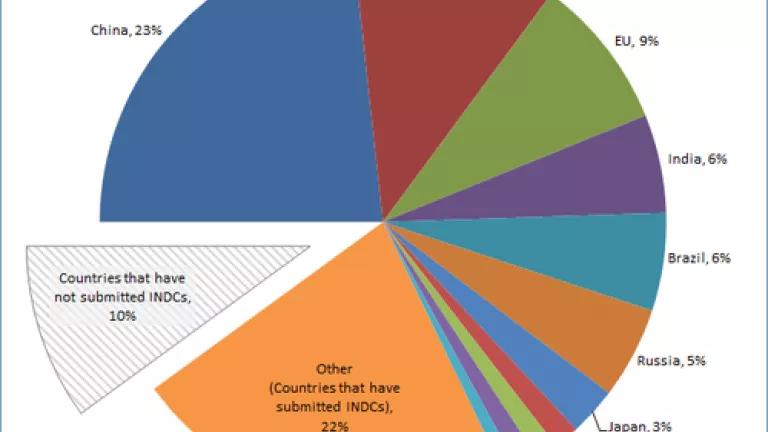Building a global climate agreement that will work: country action by all major emitters

Almost 20 years ago opponents to climate action ran advertising campaigns throughout the US with the tagline "it's not global and it won't work". This framing still seems to pop up from policymakers and companies that want to deny the need for climate action. So will the international climate agreement this December finally secure emission reduction commitments from all major emitters? The short answer is a definitive "yes."
The emerging framework for Paris will ensure that all key countries are contributing towards solving this challenge and eliminate the claim that others aren't acting. One-hundred and forty-seven countries accounting for around 90 percent of the world's climate pollution have already announced concrete emission reduction commitments in preparation for the Paris agreement (see figure and our compilation). Other key emitters are expected to announce their targets in the coming days. This includes emissions reduction commitments from major emitters such as China, India, Brazil, South Korea, Europe, Mexico, the US, and Indonesia. (Check out our scorecard to see how these targets stack-up).
These commitments will be enshrined in the Paris agreement with developed and developing countries reflected in the same agreement. How these will be captured is still a key point of debate, but regardless of the exact words in the agreement we will have national action plans from all major emitters captured in the agreement. This should lay to rest, once and for all, the lame excuse that we shouldn't act because the rest of the world isn't acting.
These commitments won't just be paper targets for diplomatic consumption. There will be real follow-through, both domestically and internationally. Since countries made commitments in 2009 as a part of the Copenhagen Accord, countries have been rolling up their sleeves and implementing domestic actions to move towards low-carbon economies. Their actions range from renewable targets to cap-and-trade programs to sector-specific policies. For example, more than 160 countries now have renewable energy targets and policies, China has just announced a new set of domestic actions including a national cap-and-trade program, and climate policies have been adopted in the vast majority of the major countries.
Countries have woken up to the fact that it is in their own interest to cut their carbon pollution. They have concluded that far from destroying the economy, domestic climate action produces real benefits to their citizens in terms of job creation, poverty reduced, and lives saved from pollution. And as the impacts of climate change are being felt around the world, they have seen concretely that not addressing climate change has real and lasting consequences..
Does this all add up to "solving" climate change? No, but it puts us much closer to a safer trajectory and highlights the path forward after Paris. Before countries committed to new actions in 2009 as a part of the Copenhagen Accord we were potentially headed to a five degree Celsius world - an increase in global average temperatures of 5°C (9°F) - a truly scary place to be. Recent estimates indicate that we are headed much closer towards around a 2.7°C (4.9°F) increase based upon what countries have currently proposed.**
A recent study found that with the current pledges we are headed for 3.5°C (6.3°F) pathway under an unduly pessimistic assumption that no further emissions cuts are achieved after 2030.*** If the world takes the first step in Paris, it is far more reasonable to foresee countries taking additional steps, building their climate commitments over time. Indeed, a critical outcome of the Paris agreement is a solid process for reassessing and deepening emission reduction commitments every five years.
Each of these studies of commitments to date shows that we need an agreement in Paris that spurs more effort in the years to come. As NRDC's President Rhea Suh said:
"Paris has already prompted pledges for the largest carbon cuts in history. We'll need continued leadership to build on those gains and avert the worst dangers of climate catastrophe...We need to consolidate that progress in Paris and make ready for the road ahead...Paris must help to accelerate this growing momentum for action and change."
We now have a clearer view of what the path after Paris must look like. We need an agreement in Paris that ensures that these actions are the floor, not the ceiling of ambition. We need to use tools like the Montreal Protocol to drive additional cuts in key sectors. And we need to help spur even greater action from cities, states/provinces, businesses, and financial institutions to help lead to even greater emissions cuts in the real-world.
The international climate actions this December can help to formalize emissions reduction from key countries and help to build the virtuous cycle of greater ambition over time.
------------------------
This post was updated with new country targets that were submitted after initial posting and based upon new analysis of the impact of the targets on temperature increases. This is based upon the INDCs submitted through November 25.
* Figure: Based upon 2012 emissions for all six greenhouse gases, including land-use change and forestry from EDGAR data.
** Note that Climate Action Tracker has estimated that the current Paris pledges (as of Oct 1, including an anticipated one from India) will put us on a 2.5 to 2.7°C path.
*** A recent estimate from Climate Interactive based upon current pledges (as of Sept 15) will put us on 3.5°C path. Note that Climate Interactive analysis assumes that no additional emissions cuts occur from 2030 to 2100. This is an unrealistic scenario as the agreement will likely require countries to regularly update targets. A "continued action" scenario gets us towards a 3.3°C pathway, but even this scenario assumes a number of key countries don't increase action after 2030.

